Enhanced Treatment of Potato Starch Wastewater Using Chitosan-Modified Biochar Film Adsorption Coupled with Ultrafiltration
Abstract
:1. Introduction
2. Materials and Methods
2.1. Sample Preparation
2.1.1. Preparation of Corn Stover BC
2.1.2. Preparation of CS/BC Film
2.2. Potato Starch Wastewater Preparation
2.3. Determination of COD, NH3-N, Total Phosphorus (TP)
2.4. Material Characterization Method and Principle
2.4.1. Scanning Electron Microscope Analysis (SEM)
2.4.2. Fourier Transform Infrared Spectral Analysis (FTIR)
2.4.3. X-ray Diffractometer (XRD)
2.4.4. Specific Surface Area Analysis (BET)
2.5. Adsorption Experiments
2.5.1. Adsorption Kinetics Experiment
2.5.2. Isothermal Adsorption Experiment
3. Results and Discussion
3.1. Material Characterization Method and Principle
3.1.1. XRD Analysis
3.1.2. FTIR Analysis
3.1.3. SEM Analysis
3.1.4. BET Analysis
3.2. Optimization of Potato Starch Wastewater Adsorption Process
3.2.1. Effect of Modification Conditions on the Adsorption Effect of Potato Starch Wastewater
3.2.2. Effect of Adsorption Temperature on the Adsorption Effect of Potato Starch Wastewater
3.2.3. Effect of Adsorption Time on the Adsorption Effect of Potato Starch Wastewater
3.2.4. Effect of Adsorbent Dosage on the Adsorption Effect of Potato Starch Wastewater
3.2.5. Treatment of Potato Starch Wastewater by Ultrafiltration Method
3.3. Adsorption Experiment
3.3.1. Adsorption Kinetics
3.3.2. Adsorption Isotherm Model
4. Conclusions
Author Contributions
Funding
Institutional Review Board Statement
Informed Consent Statement
Data Availability Statement
Conflicts of Interest
References
- Wu, D. Recycle Technology for Waste Residue in Potato Starch Processing: A Review. Procedia Environ. Sci. 2016, 31, 108–112. [Google Scholar] [CrossRef]
- Ahmed, M.A.; Mohamed, A.A. The use of chitosan-based composites for environmental remediation: A review. Int. J. Biol. Macromol. 2023, 242 Pt 2, 124787. [Google Scholar] [CrossRef]
- Ren, Y.; Ma, Y.; Min, G.; Zhang, W.; Lv, L.; Zhang, W. A mini review of multifunctional ultrafiltration membranes for wastewater decontamination: Additional functions of adsorption and catalytic oxidation. Sci. Total Environ. 2021, 762, 143083. [Google Scholar] [CrossRef]
- Luo, K.; Pang, Y.; Wang, D.; Li, X.; Wang, L.; Lei, M.; Huang, Q.; Yang, Q. A critical review on the application of biochar in environmental pollution remediation: Role of persistent free radicals (PFRs). J. Environ. Sci. 2021, 108, 201–216. [Google Scholar] [CrossRef]
- Spoială, A.; Ilie, C.I.; Ficai, D.; Ficai, A.; Andronescu, E. Chitosan-Based Nanocomposite Polymeric Membranes for Water Purification—A Review. Materials 2021, 14, 2091. [Google Scholar] [CrossRef]
- Cheng, N.; Wang, B.; Wu, P.; Lee, X.; Xing, Y.; Chen, M.; Gao, B. Adsorption of emerging contaminants from water and wastewater by modified biochar: A review. Environ. Pollut. 2021, 273, 116448. [Google Scholar] [CrossRef]
- Zhang, Z.; Li, X.; Liu, H.; Zamyadi, A.; Guo, W.; Wen, H.; Gao, L.; Nghiem, L.D.; Wang, Q. Advancements in detection and removal of antibiotic resistance genes in sludge digestion: A state-of-art review. Bioresour. Technol. 2022, 344 Pt A, 126197. [Google Scholar] [CrossRef]
- Wang, J.; Wang, L.; Yu, H.; Zain-Ul-Abdin Chen, Y.; Chen, Q.; Zhou, W.; Zhang, H.; Chen, X. Recent progress on synthesis, property and application of modified chitosan: An overview. Int. J. Biol. Macromol. 2016, 88, 333–344. [Google Scholar] [CrossRef]
- Ko, J.A.; Park, H.J.; Hwang, S.J.; Park, J.B.; Lee, J.S. Preparation and characterization of chitosan microparticles intended for controlled drug delivery. Int. J. Pharm. 2002, 249, 165–174. [Google Scholar] [CrossRef]
- Wang, X.; Guo, Z.; Hu, Z.; Zhang, J. Recent advances in biochar application for water and wastewater treatment: A review. PeerJ 2020, 8, e9164. [Google Scholar] [CrossRef]
- Vardhan, K.H.; Kumar, P.S.; Panda, R.C. A review on heavy metal pollution, toxicity and remedial measures: Current trends and future perspectives. J. Mol. Liq. 2019, 290, 111197. [Google Scholar] [CrossRef]
- Ahmed, S.F.; Kumar, P.S.; Rozbu, M.R.; Chowdhury, A.T.; Nuzhat, S.; Rafa, N.; Mahlia, T.M.I.; Ong, H.C.; Mofijur, M. Heavy metal toxicity, sources, and remediation techniques for contaminated water and soil. Environ. Technol. Innov. 2022, 25, 102114. [Google Scholar] [CrossRef]
- Gao, N.; Du, W.; Zhang, M.; Ling, G.; Zhang, P. Chitosan-modified biochar: Preparation, modifications, mechanisms and applications. Int. J. Biol. Macromol. 2022, 209, 31–49. [Google Scholar] [CrossRef]
- Li, M.; Zhu, X.; Yang, H.; Xie, X.; Zhu, Y.; Xu, G.; Hu, X.; Jin, Z.; Hu, Y.; Hai, Z.; et al. Treatment of potato starch wastewater by dual natural flocculants of chitosan and poly-glutamic acid. J. Clean. Prod. 2020, 264, 121641. [Google Scholar] [CrossRef]
- Li, H.; Zeng, X.; Shi, W.; Zhang, H.; Huang, S.; Zhou, R.; Qin, X. Recovery and purification of potato proteins from potato starch wastewater by hollow fiber separation membrane integrated process. Innov. Food Sci. Emerg. Technol. 2020, 63, 102380. [Google Scholar] [CrossRef]
- Liu, Q.; Wang, Y.; Sun, S.; Tang, F.; Chen, H.; Chen, S.; Zhao, C.; Li, L. A novel chitosan-biochar immobilized microorganism strategy to enhance bioremediation of crude oil in soil. Chemosphere 2023, 313, 137367. [Google Scholar] [CrossRef]
- Xu, H.; Li, X.; Gao, M.; Hu, X.; Zhang, X.; Li, Y.; Xu, X.; Hu, J.; Tang, C.; Hu, X. Chitosan and biochar synergize the efficient elimination of lead from wastewater by sulfidised nano-zero-valent iron. J. Environ. Chem. Eng. 2022, 10, 107101. [Google Scholar] [CrossRef]
- Zhang, X.; Zheng, H.; Wu, J.; Chen, W.; Chen, Y.; Gao, X.; Yang, H.; Chen, H. Physicochemical and adsorption properties of biochar from biomass-based pyrolytic polygeneration:effects of biomass species and temperature. Biochar 2021, 3, 657–670. [Google Scholar]
- Wysokinski, A.; Kalembasa, S.; Kuziemska, B. The content of chromium and copper in plants and soil fertilized with sewage sludge with addition of various amounts of CaO and lignite ash. Soil Sci. Annu. 2016, 67, 117. [Google Scholar] [CrossRef]
- Wang, Y.; Xiao, X.; Xu, Y.; Chen, B. Environmental Effects of Silicon within Biochar (Sichar) and Carbon-Silicon Coupling Mechanisms: A Critical Review. Environ. Sci. Technol. 2019, 53, 13570–13582. [Google Scholar] [CrossRef]
- Quy, D.V.; Hieu, N.M.; Tra, P.T.; Nam, N.H.; Hai, N.H.; Thai Son, N.; Nghia, P.T.; Anh, N.T.V.; Hong, T.T.; Luong, N.H. Synthesis of silica-coated magneticnanoparticles and application in the detection of patho-genic viruses. J. Nanomater. 2013, 2013, 603940. [Google Scholar] [CrossRef]
- Liu, L.; Yang, X.; Ahmad, S.; Li, X.; Ri, C.; Tang, J.; Ellam, R.M.; Song, Z. Silicon (Si) modification of biochars from different Si-bearing precursors improves cadmium remediation. Chem. Eng. J. 2023, 457, 141194. [Google Scholar] [CrossRef]
- Zhang, S.; Yang, X.; Liu, L.; Ju, M.; Zheng, K. Adsorption behavior of selective recognition functionalized biochar to Cd (II) in wastewater. Materials 2018, 11, 299. [Google Scholar] [CrossRef]
- Ngo, H.H.; Guo, W.; Nguyen, T.H.; Luong, T.M.L.; Nguyen, X.H.; Phan, T.L.A.; Nguyen, M.P.; Nguyen, M.K. New chitosan-biochar composite derived from agricultural waste for removing sulfamethoxazole antibiotics in water. Bioresour. Technol. 2023, 385, 129384. [Google Scholar]
- Mistar, E.M.; Ahmad, S.; Muslim, A.; Alfatah, T.; Supardan, M.D. Preparation and characterization of a high surface area of activated carbon from Bambusa vulgaris—Effect of NaOH activation and pyrolysis temperature. In IOP Conference Series: Materials Science and Engineering; IOP Publishing: Bristol, UK, 2018; Volume 334, p. 012051. [Google Scholar]
- Fan, H.; Ma, X.; Zhou, S.; Huang, J.; Liu, Y.; Liu, Y. Highly efficient removal of heavy metal ions by carboxymethyl cellulose-immobilized Fe3O4 nanoparticles prepared via high-gravity technology. Carbohydr. Polym. 2019, 213, 39–49. [Google Scholar] [CrossRef]
- Riaz, M.; Yasmeen, T.; Arif, M.S.; Ashraf, M.A.; Hussain, Q.; Shahzad, S.M.; Rizwan, M.; Mehmood, M.W.; Zia, A.; Mian, I.A.; et al. Variations in morphological and physiological traits of wheat regulated by chromium species in long-term tannery effluent irrigated soils. Chemosphere 2019, 222, 891–903. [Google Scholar] [CrossRef]
- Bazrafshan, E.; Mohammadi, L.; Ansari-Moghaddam, A.; Mahvi, A.H. Heavy metals removal from aqueous environments by electrocoagulation process—A systematic review. J. Environ. Health Sci. Eng. 2015, 13, 74. [Google Scholar] [CrossRef]
- Xia, D.; Li, H.; Mannering, J.; Huang, P.; Zheng, X.; Kulak, A.; Baker, D.; Iruretagoyena, D.; Menzel, R. Electrically Heatable Graphene Aerogels as Nanoparticle Supports in Adsorptive Desulfurization and High-ressure CO2 Capture. Adv. Funct. Mater. 2020, 30, 2002788. [Google Scholar] [CrossRef]
- Kolya, H.; Kang, C.W. Synthesis of starch-based smart hydrogel derived from rice-cooked wastewater for agricultural use. Int. J. Biol. Macromol. 2023, 226, 1477–1489. [Google Scholar] [CrossRef]
- Choque-Quispe, D.; Ligarda-Samanez, C.A.; Choque-Quispe, Y.; Solano-Reynoso, A.M.; Ramos-Pacheco, B.S.; Zamalloa-Puma, M.M.; Álvarez-López, G.J.; Zamalloa-Puma, A.; Choque-Quispe, K.; Alzamora-Flores, H. Multimetal removal in aqueous medium using a potato starch/nopal mucilage copolymer: A study of adsorption kinetics and isotherms. Results Eng. 2023, 18, 101164. [Google Scholar] [CrossRef]
- Zhang, T. Starch wastewater treatment and resource reuse research. J. Energy Environ. Prot. 2021, 4, 173–177+182. [Google Scholar]
- Zong, J.; Yuan, F.; Zhan, M.; Xu, W.; Cheng, G.; Yu, A. Numerical simulation of a mechanical flocculation process with multi-chambers in series. Water Sci. Technol. 2023, 87, 1945–1960. [Google Scholar] [CrossRef] [PubMed]
- Wang, X.; Huang, X.; Pan, Y. Quaternary ammonium salt of modified chitosan film preparation research progress and application. J. Chem. Eng. Equip. 2021, 8, 226–227. [Google Scholar]
- Sharifnia, S.; Khadivi, M.A.; Shojaeimehr, T.; Shavisi, Y. Characterization, isotherm and kinetic studies for ammonium ion adsorption by light expanded clay aggregate (LECA). J. Saudi Chem. Soc. 2016, 20 (Suppl. 1), S342–S351. [Google Scholar] [CrossRef]
- Rajahmundry, G.K.; Garlapati, C.; Kumar, P.S.; Alwi, R.S.; Vo, D.N. Statistical analysis of adsorption isotherm models and its appropriate selection. Chemosphere 2021, 276, 130176. [Google Scholar] [CrossRef]
- Wang, J.; Guo, X. Adsorption isotherm models: Classification, physical meaning, application and solving method. Chemosphere 2020, 258, 127279. [Google Scholar] [CrossRef]
- Hu, Q.; Lan, R.; He, L.; Liu, H.; Pei, X. A critical review of adsorption isotherm models for aqueous contaminants: Curve characteristics, site energy distribution and common controversies. J. Environ. Manag. 2023, 329, 117104. [Google Scholar] [CrossRef]
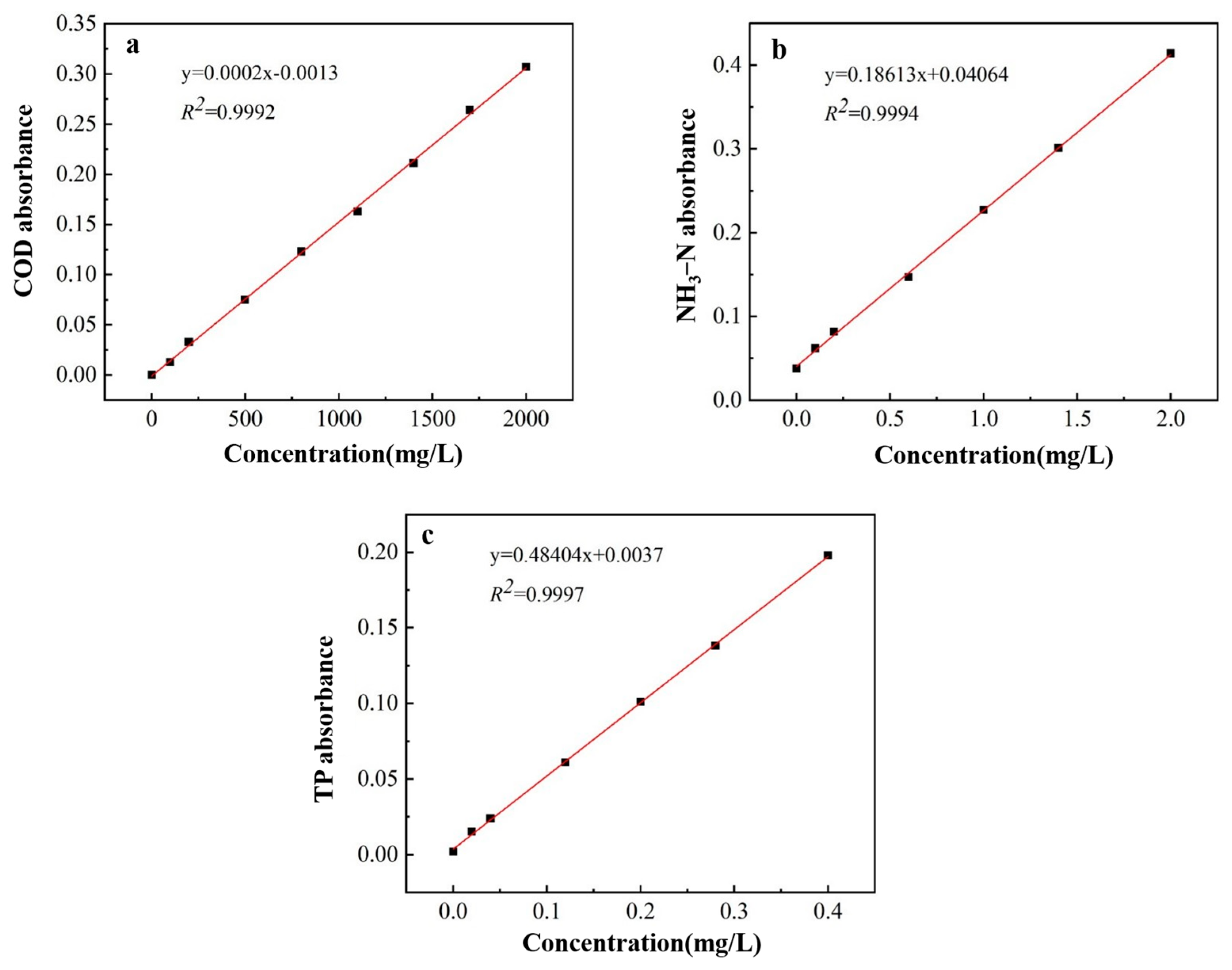
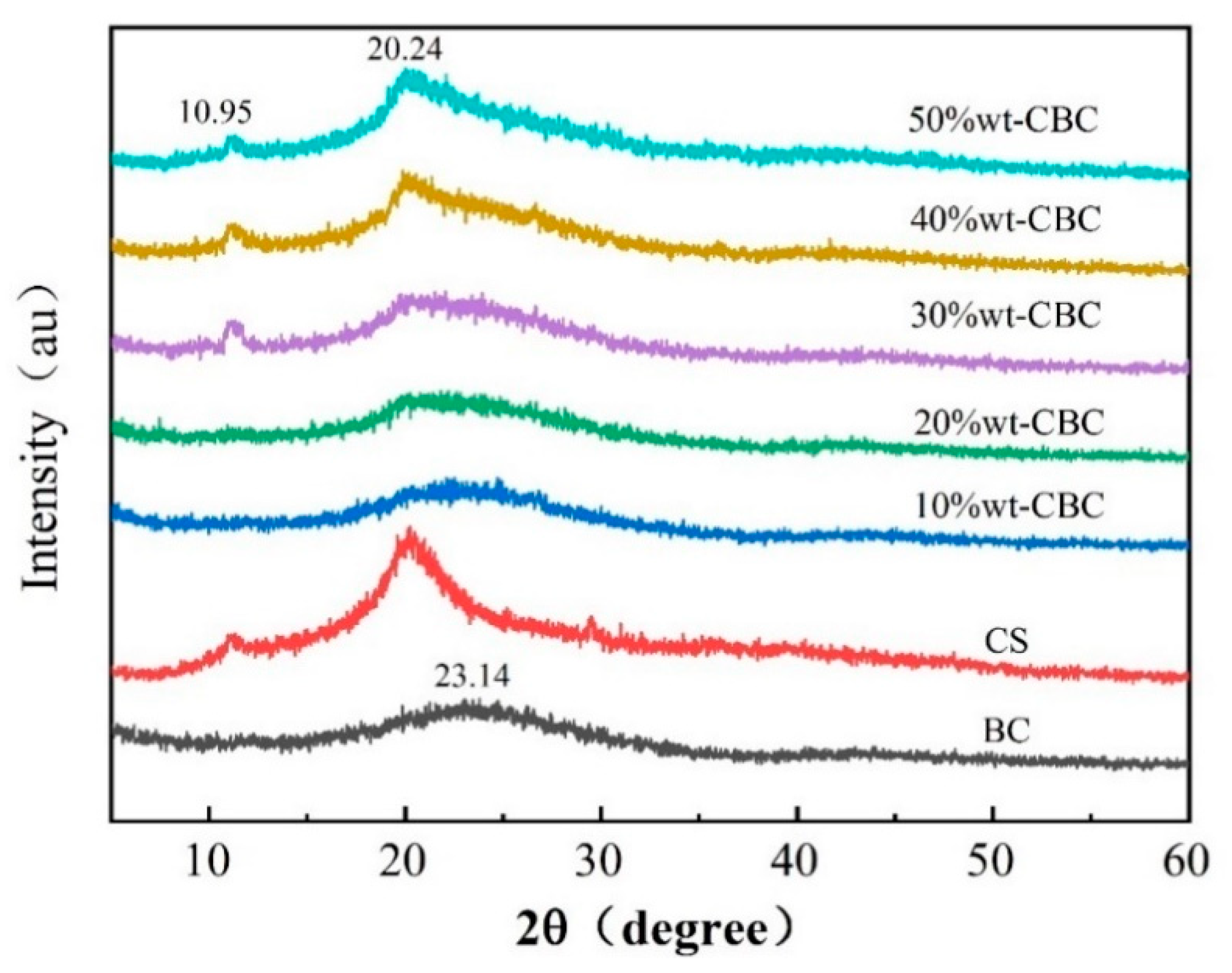
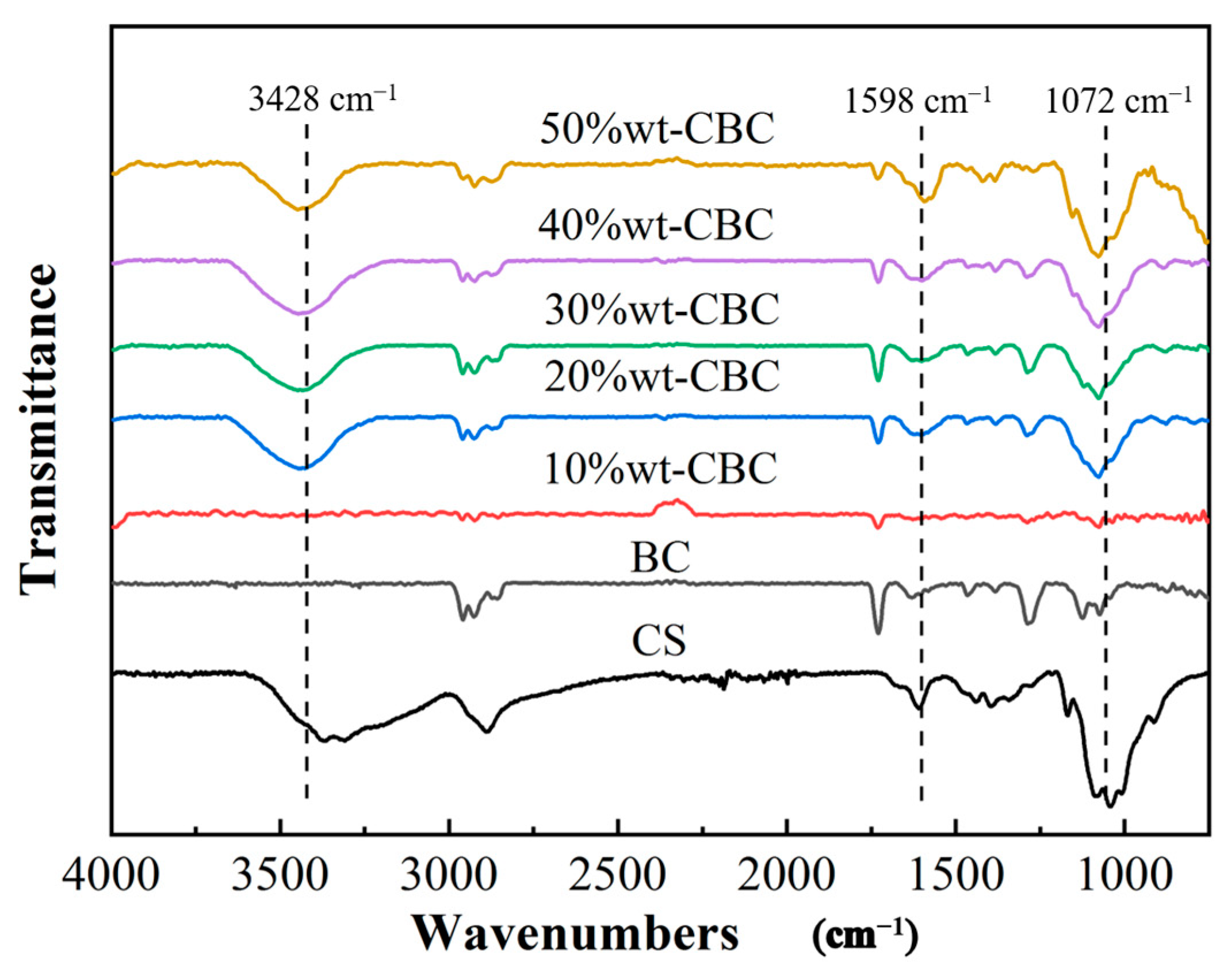


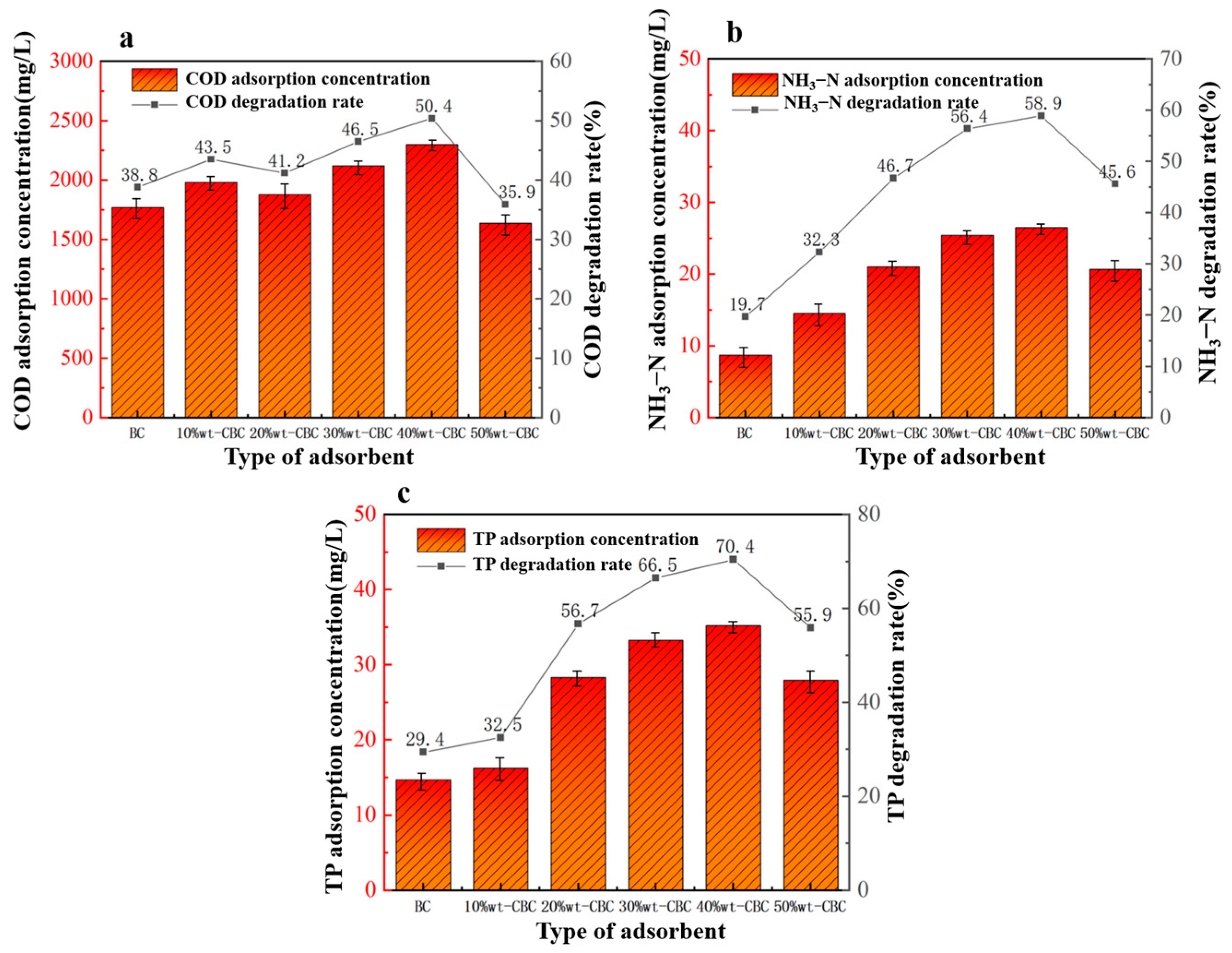
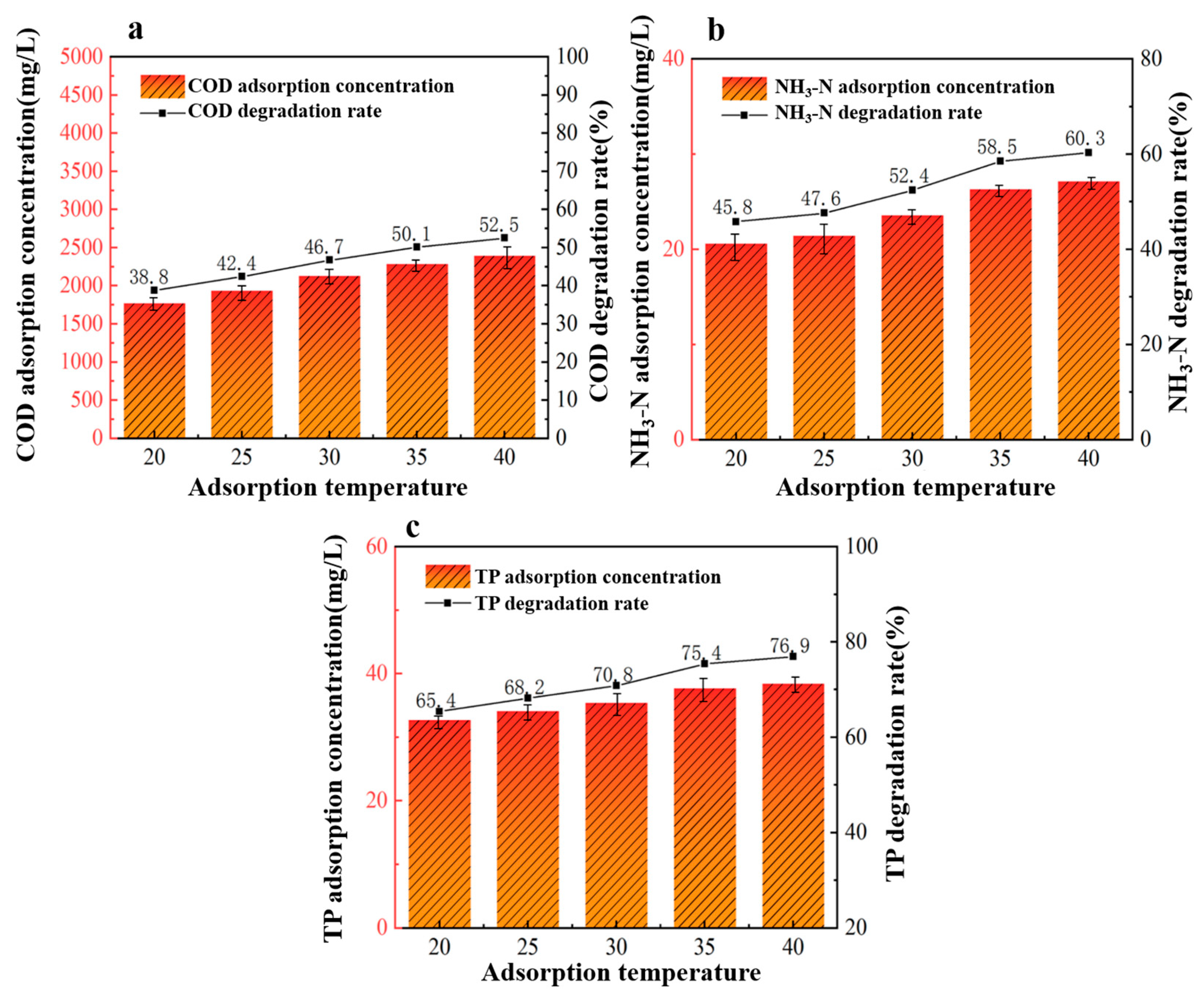
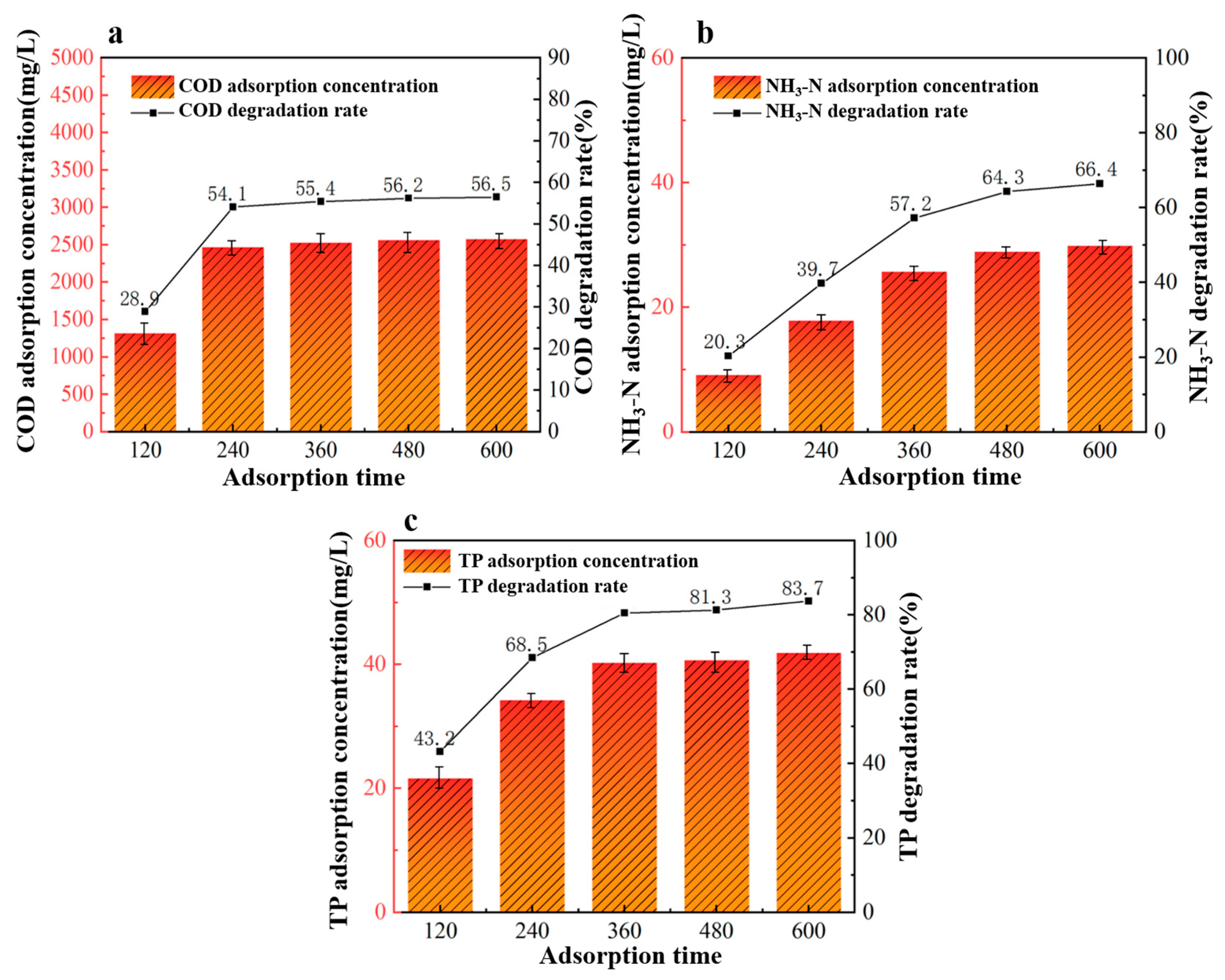

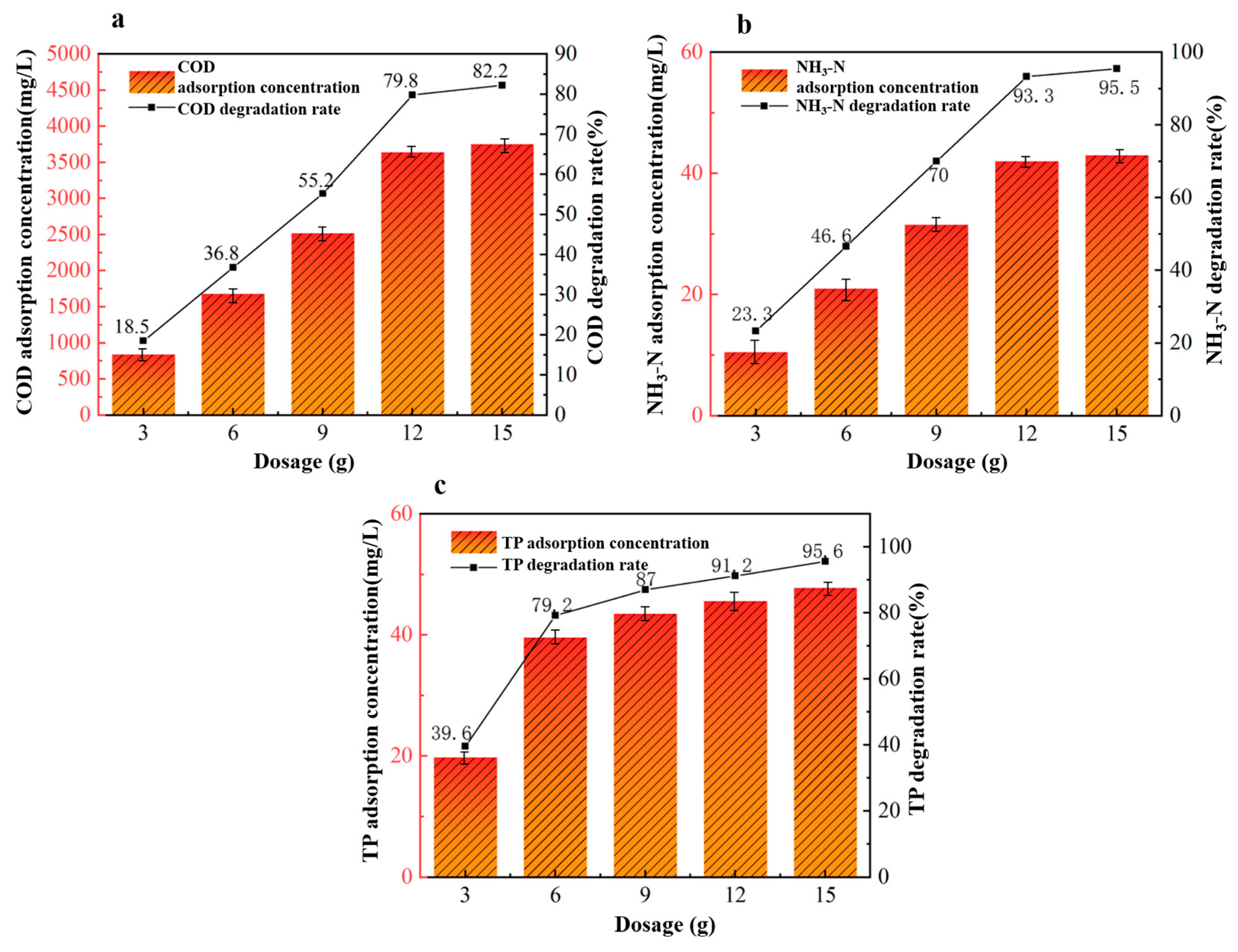
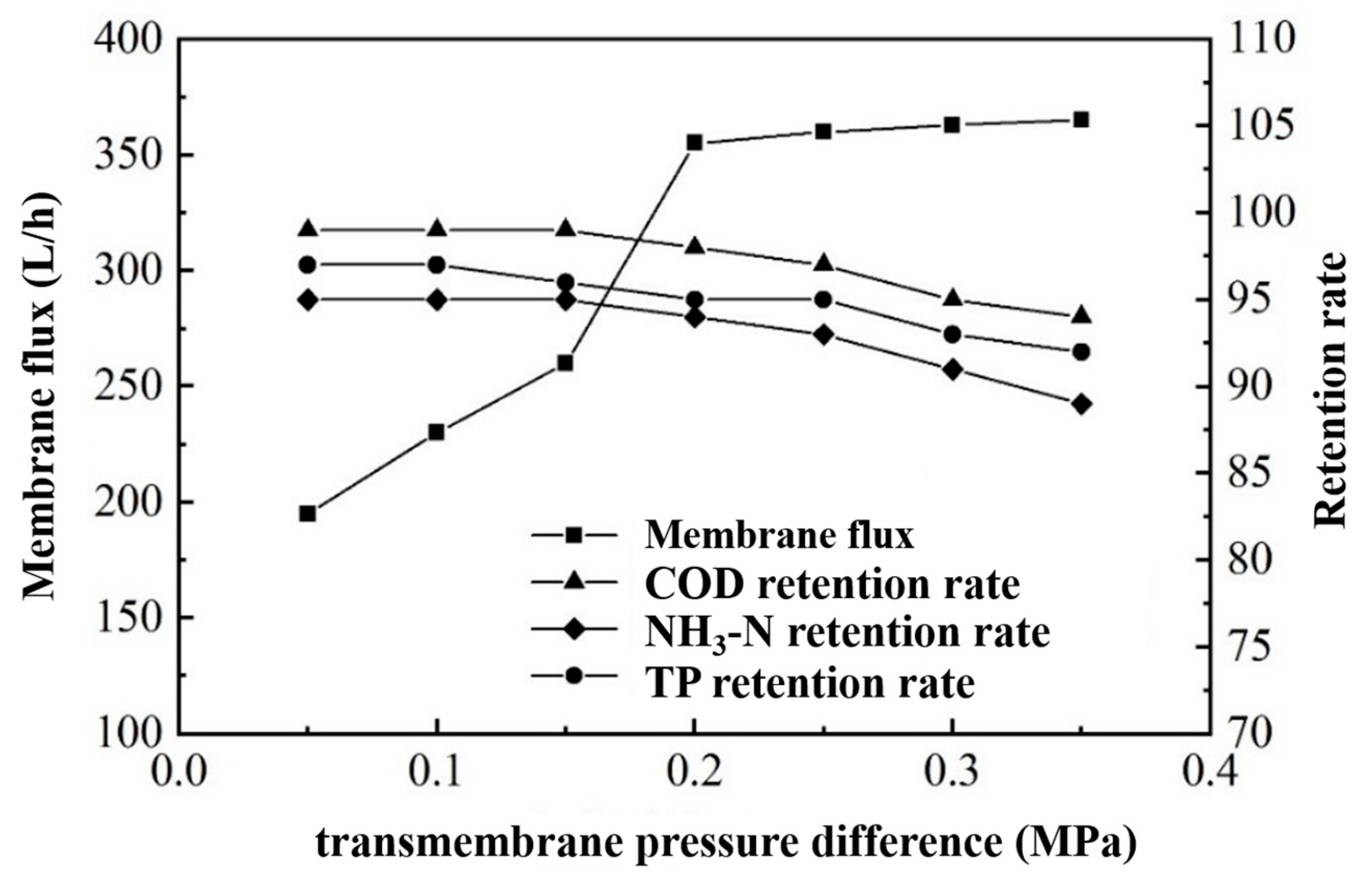
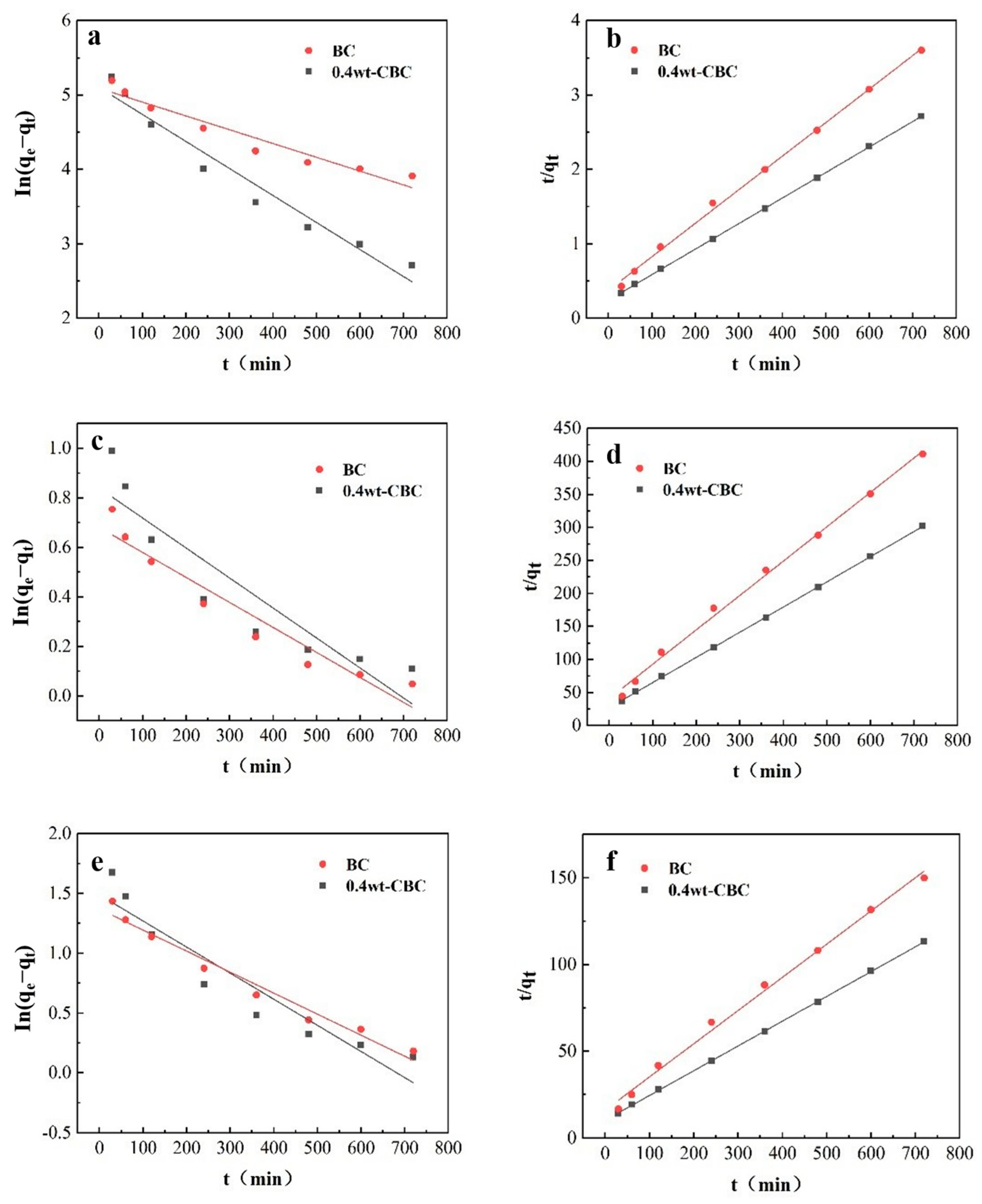
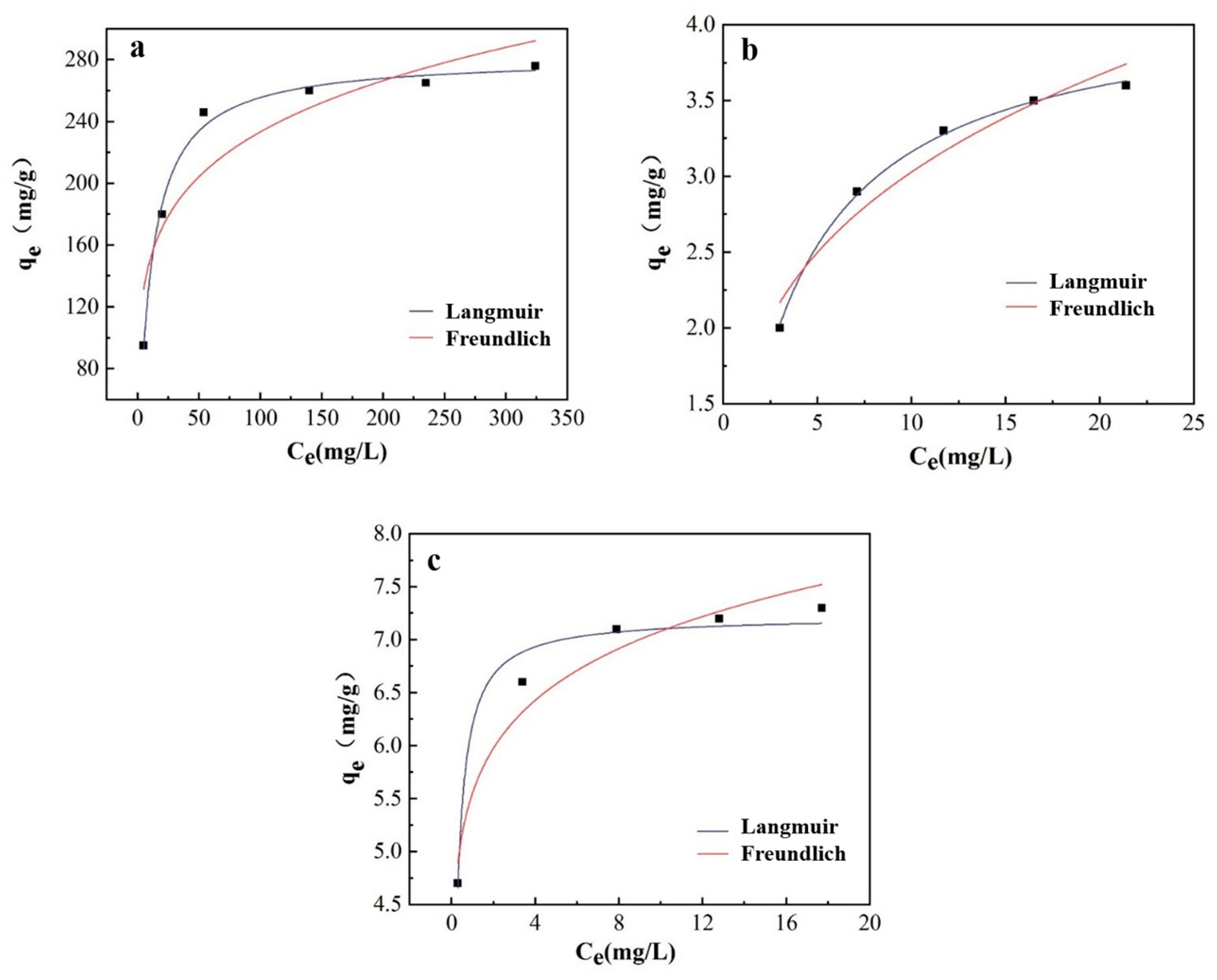
| Outgrowth | CS(g) | Corn Stover BC (g) |
|---|---|---|
| 10%wt-CBC | 0.2 | 1.8 |
| 20%wt-CBC | 0.4 | 1.6 |
| 30%wt-CBC | 0.6 | 1.4 |
| 40%wt-CBC | 0.8 | 1.2 |
| 50%wt-CBC | 1.0 | 1.0 |
| Norm | Chemical Oxygen Demand (CODcr) (mg/L) | Carbohydrate (mg/L) | Suspension (mg/L) | pH |
|---|---|---|---|---|
| Concentration | 8000~20,000 | 2000~5000 | 3000 | 4.5–6 |
| Sample | BET Surface Area (m2·g−1) | Pore Volume (cm3·g−1) | Pore Size (nm) |
|---|---|---|---|
| BC | 56.1794 | 0.1186 | 8.4481 |
| 10%wt-CBC | 80.3933 | 0.1116 | 5.5553 |
| 20%wt-CBC | 78.6006 | 0.1577 | 8.0303 |
| 30%wt-CBC | 72.0023 | 0.1935 | 10.7507 |
| 40%wt-CBC | 66.0031 | 0.1331 | 8.0691 |
| 50%wt-CBC | 50.6008 | 0.1266 | 10.0122 |
| COD mg/L | NH3-N mg/L | TP mg/L | Turbidity NTU | |
|---|---|---|---|---|
| Measured value | 24 | 0.2 | 0.25 | 2 |
| Standard value | ≤60 | ≤10 | ≤1 | ≤5 |
| Absorbent | Absorbent Agent | qe(exp) (mg/g) | qe(cal) (mg/g) | K1 (min−1) | R2 |
|---|---|---|---|---|---|
| COD | BC | 255 | 162.43 | 0.00185 | 0.9272 |
| 40%wt-CBC | 282 | 164.55 | 0.00363 | 0.9515 | |
| NH3-N | BC | 2.8 | 1.98 | 0.00101 | 0.9173 |
| 40%wt-CBC | 3.5 | 2.32 | 0.00121 | 0.8274 | |
| TP | BC | 6.0 | 3.94 | 0.00176 | 0.9666 |
| 40%wt-CBC | 7.5 | 4.43 | 0.00218 | 0.8841 |
| Absorbent | Absorbent Agent | qe(exp) (mg/g) | qe(cal) (mg/g) | K2 (min−1) | R2 |
|---|---|---|---|---|---|
| COD | BC | 255 | 221.73 | 0.01201 | 0.9977 |
| 40%wt-CBC | 280 | 291.55 | 0.01405 | 0.9999 | |
| NH3-N | BC | 2.8 | 1.92 | 0.01271 | 0.9957 |
| 40%wt-CBC | 3.5 | 2.62 | 0.01405 | 0.9998 | |
| TP | BC | 6.0 | 5.22 | 0.01196 | 0.9941 |
| 40%wt-CBC | 7.5 | 7.00 | 0.01406 | 0.9998 |
| Absorbent | Absorbent Agent | Langmuir | Freundlich | ||||
|---|---|---|---|---|---|---|---|
| qm(mg/g) | Kl (L/mg) | R2 | KF (L/mg) | 1/n | R2 | ||
| COD | 40%wt-CBC | 281.59 | 0.09814 | 0.9914 | 96.49 | 0.1917 | 0.8287 |
| NH3-N | 4.17 | 0.31418 | 0.9981 | 1.60 | 0.2776 | 0.9303 | |
| TP | 7.22 | 6.05856 | 0.9685 | 5.55 | 0.1055 | 0.9417 | |
Disclaimer/Publisher’s Note: The statements, opinions and data contained in all publications are solely those of the individual author(s) and contributor(s) and not of MDPI and/or the editor(s). MDPI and/or the editor(s) disclaim responsibility for any injury to people or property resulting from any ideas, methods, instructions or products referred to in the content. |
© 2023 by the authors. Licensee MDPI, Basel, Switzerland. This article is an open access article distributed under the terms and conditions of the Creative Commons Attribution (CC BY) license (https://creativecommons.org/licenses/by/4.0/).
Share and Cite
Zuo, J.; Zhao, T.; Yang, S.; Xia, Z.; Tan, C.; Li, J.; Wang, Y. Enhanced Treatment of Potato Starch Wastewater Using Chitosan-Modified Biochar Film Adsorption Coupled with Ultrafiltration. Coatings 2023, 13, 2017. https://doi.org/10.3390/coatings13122017
Zuo J, Zhao T, Yang S, Xia Z, Tan C, Li J, Wang Y. Enhanced Treatment of Potato Starch Wastewater Using Chitosan-Modified Biochar Film Adsorption Coupled with Ultrafiltration. Coatings. 2023; 13(12):2017. https://doi.org/10.3390/coatings13122017
Chicago/Turabian StyleZuo, Jinlong, Tingting Zhao, Shaodong Yang, Zhi Xia, Chong Tan, Junsheng Li, and Yuyang Wang. 2023. "Enhanced Treatment of Potato Starch Wastewater Using Chitosan-Modified Biochar Film Adsorption Coupled with Ultrafiltration" Coatings 13, no. 12: 2017. https://doi.org/10.3390/coatings13122017
APA StyleZuo, J., Zhao, T., Yang, S., Xia, Z., Tan, C., Li, J., & Wang, Y. (2023). Enhanced Treatment of Potato Starch Wastewater Using Chitosan-Modified Biochar Film Adsorption Coupled with Ultrafiltration. Coatings, 13(12), 2017. https://doi.org/10.3390/coatings13122017





